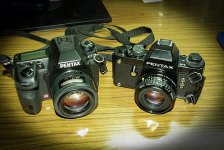Phil_F_NM
Camera hacker
This same conjecture comes up every so often with the same viewpoints and desires brought up. We all wish for a full frame digital Nikon F2 or F3 or FM/2/3a or SP/S3/S2. Or Canon F1n (hell, even the ability to use FD/FL lenses on DSLRs today), or Pentax LX, MX, or Olypmus OM1/2/3/4. Some folks out there may even want a Minolta digital. 🙂
Yes, cameras are more rounded ergonomic blobs but those blobs stick to the hand much better than a Nikon F2 with a classis fast lens on it. The ergonomics are so good that it isn't as painful to shoot for 10 hours with one of the modern film SLRs or any of the DSLRs as it is to do the same with an older angular "classic" build SLR. If the manufacturers of those old chunky bricks had the ability to create the ergonomic profiles of the T90/F4 and successive SLRs they would have done so decades prior.
Over the last month I've been shooting a Nikon D3 using only manual focus Ai and AiS lenses. I added a DK17-m, provided by Dave Lackey. Have a 28mm and 50mm graciously provided by Calzone and Sanmich, respectively. I shopped around and found a few other very top-end Nikkors for almost nothing as well. Yesterday, I stuck a Canon EC-B focusing screen into the D3. With the focusing screen and the user profile I have created for my manual lenses, I now am shooting the very best manual DSLR I think I could dream of.
Hands down, nothing comes close to the programmability of modern DSLRs and some of the best ones allow the user to create a personal profile that allows one to shoot exactly the way they want. So now I feel like my D3 is a digital version of my old F4s with a J screen and a better light meter.
While I would love a full frame Nikon SP, I think those days are gone and in spite of my love for that system as well as the Leica M, I'm realy thankful for the technological wonder of cameras such as the D3 and the customization that engineers built in to it. So I would take the digital SP out for a "Sunday drive" but for working, I prefer a camera that is comfortable in the hand for hours at a time and has all the ability and function of a modern DSLR.
Phil Forrest
Yes, cameras are more rounded ergonomic blobs but those blobs stick to the hand much better than a Nikon F2 with a classis fast lens on it. The ergonomics are so good that it isn't as painful to shoot for 10 hours with one of the modern film SLRs or any of the DSLRs as it is to do the same with an older angular "classic" build SLR. If the manufacturers of those old chunky bricks had the ability to create the ergonomic profiles of the T90/F4 and successive SLRs they would have done so decades prior.
Over the last month I've been shooting a Nikon D3 using only manual focus Ai and AiS lenses. I added a DK17-m, provided by Dave Lackey. Have a 28mm and 50mm graciously provided by Calzone and Sanmich, respectively. I shopped around and found a few other very top-end Nikkors for almost nothing as well. Yesterday, I stuck a Canon EC-B focusing screen into the D3. With the focusing screen and the user profile I have created for my manual lenses, I now am shooting the very best manual DSLR I think I could dream of.
Hands down, nothing comes close to the programmability of modern DSLRs and some of the best ones allow the user to create a personal profile that allows one to shoot exactly the way they want. So now I feel like my D3 is a digital version of my old F4s with a J screen and a better light meter.
While I would love a full frame Nikon SP, I think those days are gone and in spite of my love for that system as well as the Leica M, I'm realy thankful for the technological wonder of cameras such as the D3 and the customization that engineers built in to it. So I would take the digital SP out for a "Sunday drive" but for working, I prefer a camera that is comfortable in the hand for hours at a time and has all the ability and function of a modern DSLR.
Phil Forrest


